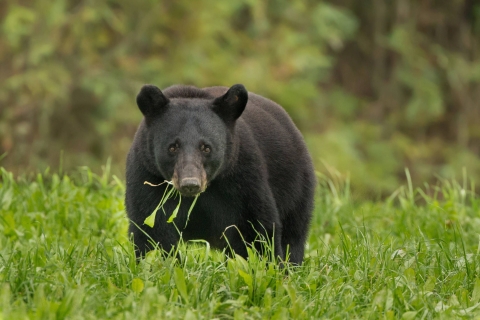About Us
Theodore Roosevelt NWR is located near the site of President Roosevelt’s famous Mississippi bear hunt held in 1902. Although current acreage is very small and the Refuge is closed to the public, it is involved in active land acquisition and will someday offer educational and interpretive information to the public about the former president's legacy in the Delta.
Louisiana black bears, a subspecies of the American black bear, were once extremely common throughout Mississippi, Louisiana, and Texas. President Roosevelt came as the guest of a prominent plantation owner to hunt in southern Sharkey County. Holt Collier, a famous African American bear hunter and outdoorsman, was hired to guide the president on the hunt.
Although some details of the story have become obscured over time, the main details are almost universally agreed upon. Holt Collier’s dogs quickly located a bear and the president and his companion were told to wait on the edge of a canebrake for the bear to come out. When it seemed the dogs were moving in a different direction, President Roosevelt went back to camp for lunch. When the dogs finally cornered the bear, Collier jumped off of his horse and hit the bear in the head with the stock of his rifle, leaving the bear stunned. He then tied a rope around the bear and sent for the president.
When the president arrived, he found a bear that was still knocked senseless. President Roosevelt felt it would be unethical and unsportsmanlike to shoot the bear and refused, despite the urging of his companions. When the national press got word of the story, the news went wild in news stories and cartoons. A toy shop owner in New York decided to stuff toy bears and call them “Teddy’s Bears,” creating an American icon that has lasted for over a century.
Our Mission
In 2004, Theodore Roosevelt NWR was formed under the Fish and Wildlife Coordination Act (16 U.S.C. § 664). In 2004.
Administration; rules and regulations; availability of lands to State agencies such areas as are made available to the Secretary of the Interior for the purposes of sections 661 to 666c of this title, pursuant to sections 661 and 663 of this title or pursuant to any other authorization, shall be administered by him directly or in accordance with cooperative agreements entered into pursuant to the provisions of section 661 of this title and in accordance with such rules and regulations for the conservation, maintenance, and management of wildlife, resources thereof, and its habitat thereon, as may be adopted by the Secretary in accordance with general plans approved jointly by the Secretary of the Interior and the head of the department or agency exercising primary administration of such areas: Provided, That such rules and regulations shall not be inconsistent with the laws for the protection of fish and game of the States in which such area is situated: Provided, further, That lands having value to the National Migratory Bird Management Program may, pursuant to general plans, be made available without cost directly to the State agency having control over wildlife resources, if it is jointly determined by the Secretary of the Interior and such State agency that this would be in the public interest: And provided further, That the Secretary of the Interior shall have the right to assume the management and administration of such lands in behalf of the National Migratory Bird Management Program if the Secretary finds that the State agency has withdrawn from or otherwise relinquished such management and administration.
Our History
The Theodore Roosevelt National Refuge is named after former President Roosevelt who was a great conservationist. He came to Onward, MS, near to where the refuge now sits, in 1902, in pursuit of the Louisiana black bear. He was led by Holt Collier, a great sportsman and former slave who killed more than 3000 bears in his lifetime. Read more about Holt Collier here (hyperlink to Holt Collier NWR).
While on a bear hunting trip in Onward, Mississippi, Holt Collier single-handedly cornered a large adult male Louisiana black bear, knocked it out with the butt of his gun, tied it to a willow tree and suggested that the president shoot it. Viewing this as unsportsmanlike, President Roosevelt refused to kill the bear. Political cartoonist Clifford Berryman heard the story and drew a cartoon celebrating the president’s decision. A Brooklyn candy shop owner by the name of Morris Michtom saw the cartoon and decided to create a stuffed toy bear and dedicate it to the president, who refused to shoot a bear. He called it Teddy's Bear and children have been enjoying them ever since. Without this famous hunt, Holt Collier, and Theodore Roosevelt, we may have never had teddy bears!
Other Facilities in this Complex
Theodore Roosevelt National Wildlife Refuge is one of nine refuges that make up the Theodore Roosevelt National Wildlife Refuge Complex. Each refuge in the complex plays vital role to conserving our nation's resources. A National Wildlife Refuge Complex is an administrative grouping of two or more Refuges, wildlife management areas or other Refuge conservation areas that are primarily managed from a central office location. Refuges are grouped into a complex structure because they occur in a similar ecological region, such as a watershed or specific habitat type, and have a related purpose and management needs. Typically, a Project Leader oversees the general management of all Refuges within the complex and Refuge Managers are responsible for operations at specific Refuges. Supporting staff, composed of administrative, law enforcement, Refuge manager, biological, fire, visitor services, and maintenance professionals, are centrally located and support all Refuges within the complex.
Checkout the list below of the other Refuges within the Complex, and visit each one for new and different experiences!










